After a nearly 3-year hiatus, it was time to get back out in the field to continue exploring this wondrous world. We had been in touch with Rob Smith of Wild About Colombia since 2019 and it was time to make the return trip to Colombia a reality. Our focus would be on searching for rare and endemic primates. We met Rob in Bogota on December 4 and set off early the following day for Villavicencio and our first primate target, the endemic Ornate Tití Monkey.
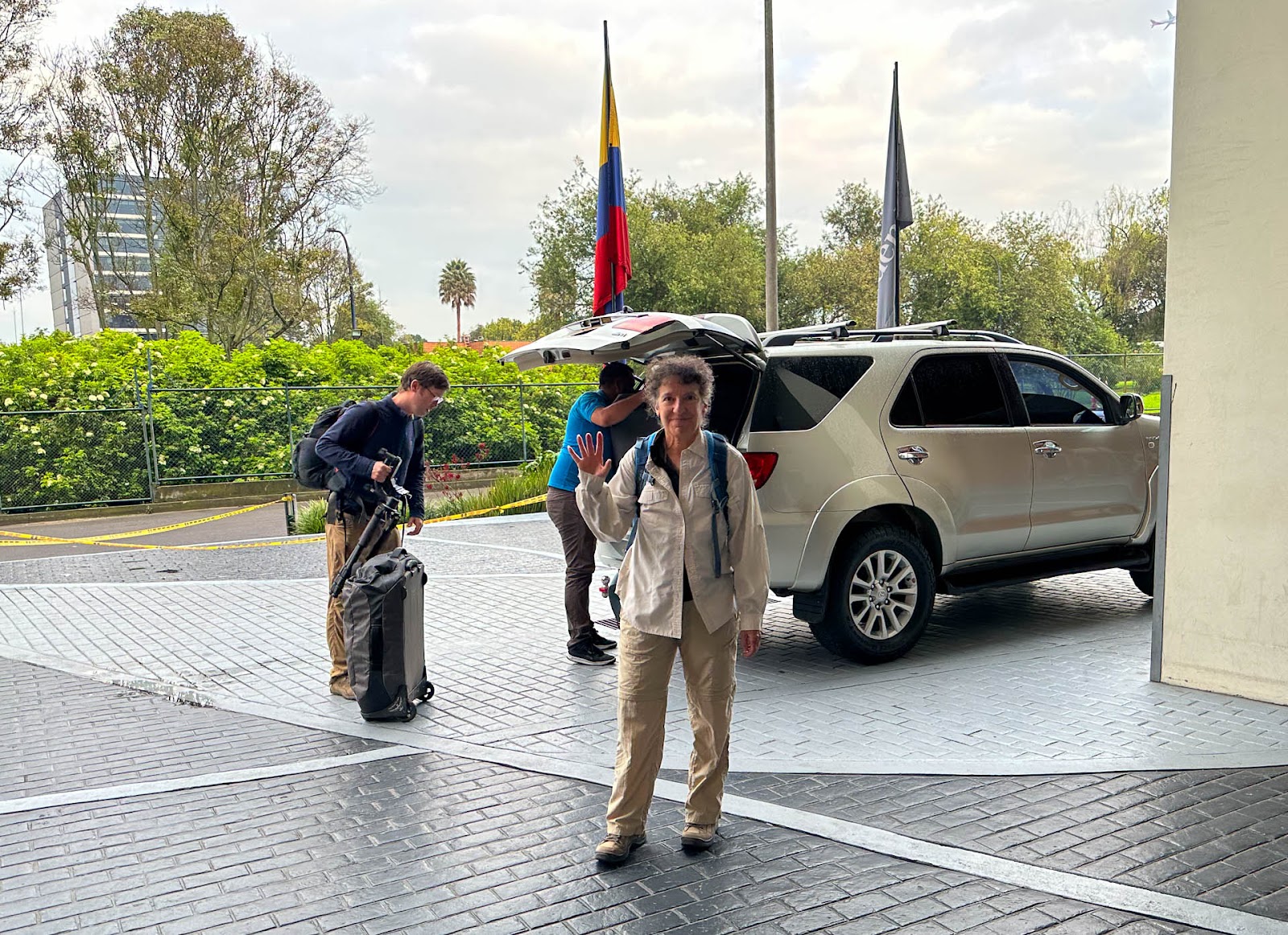 |
| Leaving Bogotá |
Surprisingly these monkeys don’t live deep in the jungles of a national park but prefer the forest edges along cattle pastures. A local NGO is working with ranchers to protect these monkeys and we were granted permission to search for them on a private finca or farm. It didn’t take long to spot our first primate, not a titi but a Colombian Squirrel Monkey, a subspecies of the widespread Humboldt’s Squirrel Monkey.
Shortly after, Rob spotted another monkey, an Ornate Tití! These titi monkeys are classified as vulnerable by the IUCN and occupy a small range in eastern Colombia. It was a treat to view this tiny family group and another on the finca.
We spent the night at Rancho Camaná, another finca that owners Martha, Nathalia, and Elvis are preserving for conservation. The family has chosen to transform their cattle ranch into a nature reserve and invite guests to visit their bird feeders, gardens, and forest. Their most notable residents were a family of Brumback’s Night Monkeys, another Colombian endemic species. Nathalia showed us their roosting place high up in a big stand of bamboo. As night approached the family left the roost and promptly went to feed in a mango tree nearby.
 |
| Brumback’s Night Monkeys |
Like so many other animals these monkeys are vulnerable due to habitat loss. Their forest home is being cleared for cattle ranching, agriculture, and human habitation. It was heartening to see Rancho Camaná doing their part to protect the Brumback’s Night Monkeys' forest home and working with others in the community to do the same.
Elvis joined us the next day to visit another finca near the town of Vista Hermosa where Colombian Woolly Monkeys are known to live. To reach this remote village, we transferred to a 1981 Toyota Landcruiser for the bumpy ride and river crossings.
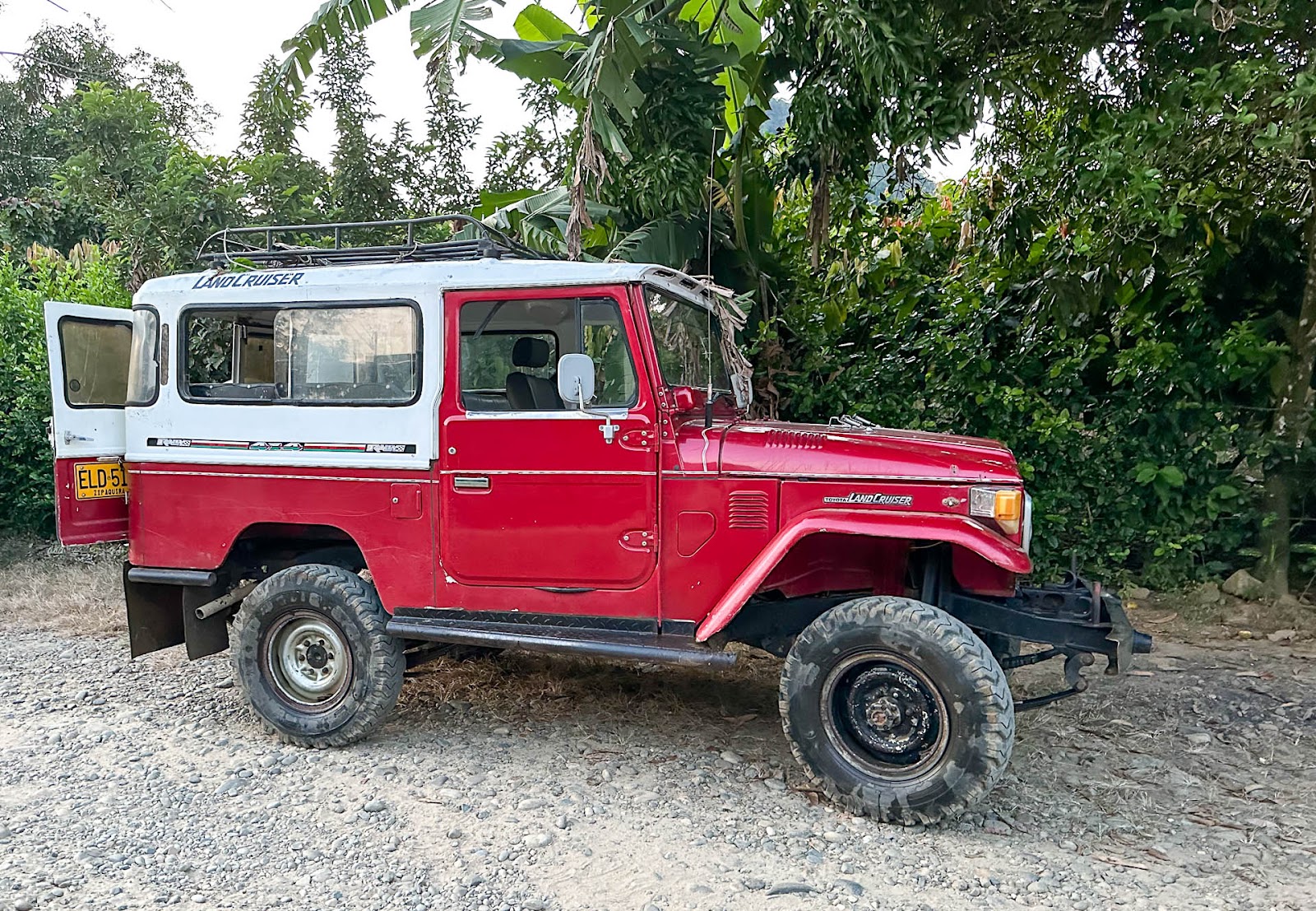 |
| 1981 Toyota Landcruiser |
We hiked a half mile along a stream when Rob spotted the Colombian Woolly Monkeys! They were quite relaxed and allowed us to approach closely for good views and photos, an indication that they are not hunted in this area. They are much darker than other woolly monkeys we’ve seen. Some scientists believe they are a subspecies of the Common Woolly Monkey while others ascertain they are a separate species. Whatever the case, they are classified as critically endangered and to see them so relaxed close to a village was amazing!
The next day brought us to another finca in search of our next primate species, the endangered White-bellied Spider Monkey. We were joined by Cesar, a local rancher who like Elvis has become more interested in conservation and ecotourism. He led us to a ridge on his farm from which we had a good view of the forest on the other side of a stream. We sat and waited for the monkeys to appear but they didn’t show. After 2 hours I had about given up hope when Cesar spotted them feeding in a tree alongside a waterfall! They were quite a distance away so we hiked along the stream to the base of the waterfall. We couldn’t get any closer but we did get good views of this family group.
We went to lunch at another farmhouse where we were treated to a local feast of sancocho, the traditional soup full of potatoes, yuca, and plantains, grilled chicken, and rice. It was a novel wildlife viewing experience for us searching for animals on privately owned fincas and then having lunch at a different farmhouse. It was Rob’s way of spreading our tourist dollars around and encouraging the locals to protect the forest and wildlife in it. If the farmers can generate income from ecotourism, they are less apt to cut the forest and hunt the wildlife.
 |
| Sancocho |
After such a hearty meal, it was off to Cesar’s lodge for a siesta. Although not quite complete, Cesar is constructing a tiny ecolodge which he hopes one day will be used by tourists visiting the area to see wildlife instead of just the waterfall. We did a bit of birding and Cesar took us to a tree behind the lodge where a Linné's Two-toed Sloth was snoozing.
We said goodbye to Cesar and wished him the best of luck with his new endeavors. We all got a bit teary-eyed when he informed us we were his first foreign guests!
The next day we said goodbye to Elvis and continued on to San Jose del Guaviare where we met our new local guide, Wilma. Not far from town was a patch of forest with a surprising diversity of primates. We saw 4 species of monkeys, three new to our trip: the Colombian Red Howler Monkey, Black-capped or Tufted Capuchin, and Common Woolly Monkey.
 |
| Common Woolly Monkey |
We had to venture further afield to the village of Cerro Azul to locate our next primate targets. On the long drive, we did manage to find one, the Collared or Black Titi Monkey in a patch of forest alongside the road. They were high in the forest canopy but came closer out of curiosity affording us a good view.
Our next two monkey species proved to be more difficult to find. We searched for the first in Cerro Azul Reserve but encountered more Common Woolly Monkeys and Tufted Capuchins before reaching the end of the trail. We headed back hoping to see our prime target on the return. Rob and Wilma heard something on the trail ahead. Could it be the elusive Golden-backed Uacaris? No, it turned out to be the even more elusive South American Tapir! Wilma and another local guide Norbe had not seen one here before. We got good views and photos despite the fading light.
 |
| South American Tapir |
We returned to the forest after dark but a night walk only produced an opossum, most likely a Brown-eared Wooly Opossum and a Linné's Two-toed Sloth that we nearly missed in a tree over our heads. We had one more day to find the uacaris so the pressure was on. We revisited the same trail the following morning with no luck so we tried another trail with the same result. We returned crestfallen to the farmhouse for lunch. Time was running out, we had to find the uacaris this afternoon or choose between them and the Mottle-face Tamarins on our final morning in the area. We set off after lunch and patrolled the same trail where they had been seen in the past.
 |
| Setting Off |
We stopped short of the trail's end and waited in vain for the monkeys to show up. We accepted defeat and started our return to the farmhouse. I turned back and noticed that Norbe was urgently trying to get our attention. He had found the Golden-backed Uacaris! We rushed back to his location and caught glimpses of them high in the trees. Not satisfied with our encounter we followed them deeper into the forest. Finally, they paused long enough to give us a proper look and for Marc to get an extraordinary photo! Unlike most New World Monkeys, they have short, non-prehensile tails. Why a monkey would evolve without a prehensile tail which comes in very handy with an arboreal lifestyle is beyond me.
 |
| Golden-backed Uacari |
The next morning we visited another finca to search for our final primate target, the Mottle-face Tamarin. The locals refer to them as "Diablitos" or "Little Devils" and I hoped they wouldn’t be difficult to find as the uacaris. We were met by the farmer who owns the finca who would hopefully guide us to the Diablitos. We were joined by Norbe and our 3 local guides who went into the forest to search for the Little Devils while we walked the forest edge on the more open pasture side. Wilma found 3 Collared Titis but no tamarins. We were seeing plenty of birds, an Ornate Hawk Eagle, a Laughing Falcon, and White-throated Toucans but no mammals. The crafty Little Devils outmaneuvered us and we returned to the farmhouse for breakfast. There were old Ocelot skins hanging on the walls. It’s a good thing that the farmers are no longer hunters and are getting into ecotourism. Just as we were finishing breakfast, Anderson, one of the farmer’s sons ran up excitedly. He had found the tamarins! We rushed off after him into the forest to the location. Sure enough, they were there, high up in the trees! We followed them, getting clear views when they paused on an open branch to screech at us.
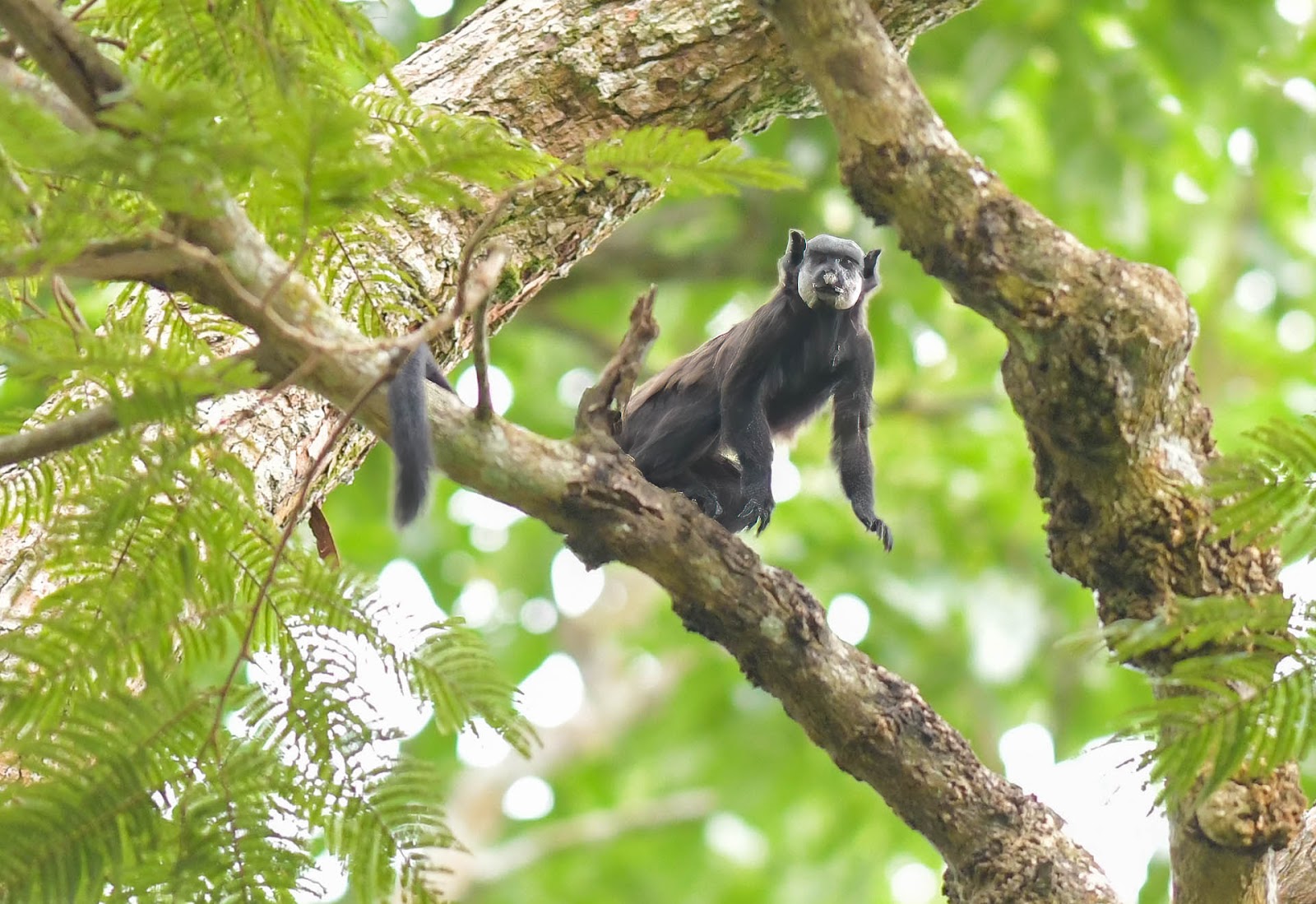 |
| Mottled-face Tamarin |
What a relief, we had seen our 10th primate target for this section of the tour. We returned to the farmhouse satisfied with our experience. We said goodbye to the family thanking them for their hospitality and of course for the Mottle-face Tamarins! It was still early enough to return to Cerro Azul to finally see the rock art for which the reserve is famous.
 |
| Hiking to Cerro Azul |
We climbed 400 feet to the main panel, an impressive collection of human and animal figures thought to be 12,000 years old! Little is known about this site including who the artists were.
 |
| The Main Panel at Cerro Azul |
To get to the upper panel we followed the trail to a cave. You can bypass the cave but we wanted to see the bats inside. Our Covid masks came in handy here and we put them on before entering the cave.
There were many bats hanging from the ceiling and we could identify the Common Vampire Bat, Lesser Dog-like Bat, Lesser Spear-nosed Bat, and Seba’s Short-tailed Bat. It was hot and I was sweating into my mask. Between the slippery rocks, the bats flying around, and trying to avoid hitting my head on the ceiling, I was relieved to see light at the other end.
We continued to a viewpoint overlooking the rainforest. It was good to see such a large swath of forest after seeing so much cleared for pasture and agriculture.
 |
| Rainforest Panorama from Cerro Azul |
From here we visited the upper panels, one with impressive tapir figures and another with a giant ground sloth now extinct.
 |
| Giant Ground Sloth |
As we headed back down, we saw something moving next to the trail. It was a Southern Tamandua! We got a brief, partially obstructed view but waited to see what the tamandua would do. Amazingly, it came back out onto the trail in full view only 20 feet away! We watched as it climbed a palm tree searching for ants. Marc got great photos although he had too much lens.
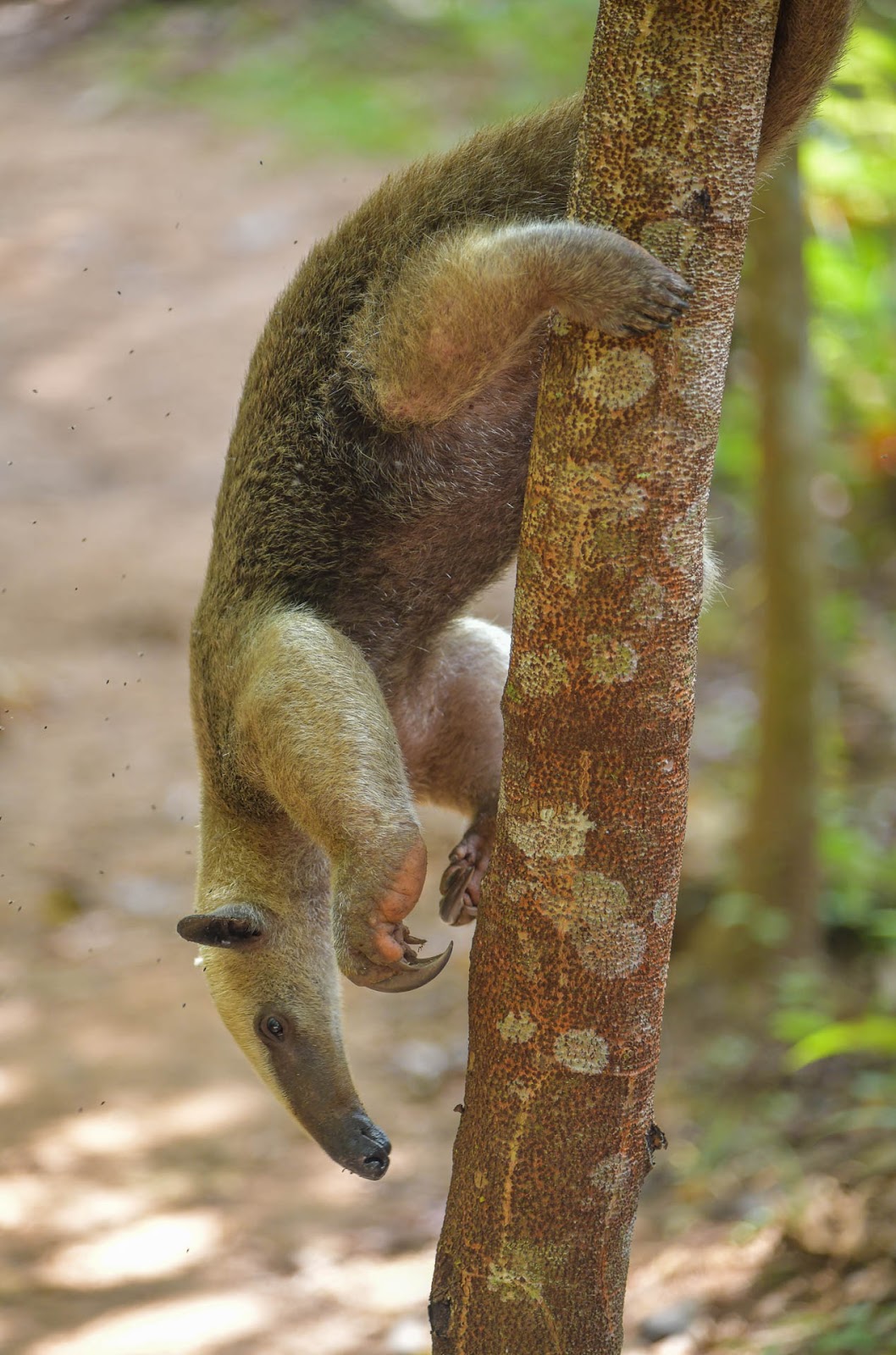 |
| Southern Tamandua |
We drove back to San Jose del Guaviare that afternoon making one detour to see the Orinoco River Dolphins. They weren’t far from the dock and Marc played whack-a-mole catching a few fins and beaks only.
The first leg of “Mission Monkey” had come to an end. We had been successful in seeing all 10 of our primate targets in addition to other mammals and many birds. Stay tuned for the second leg of our search for Colombia’s rare and endemic primates!
We hope all is well with everyone.
Peggy and Marc
Our route map:



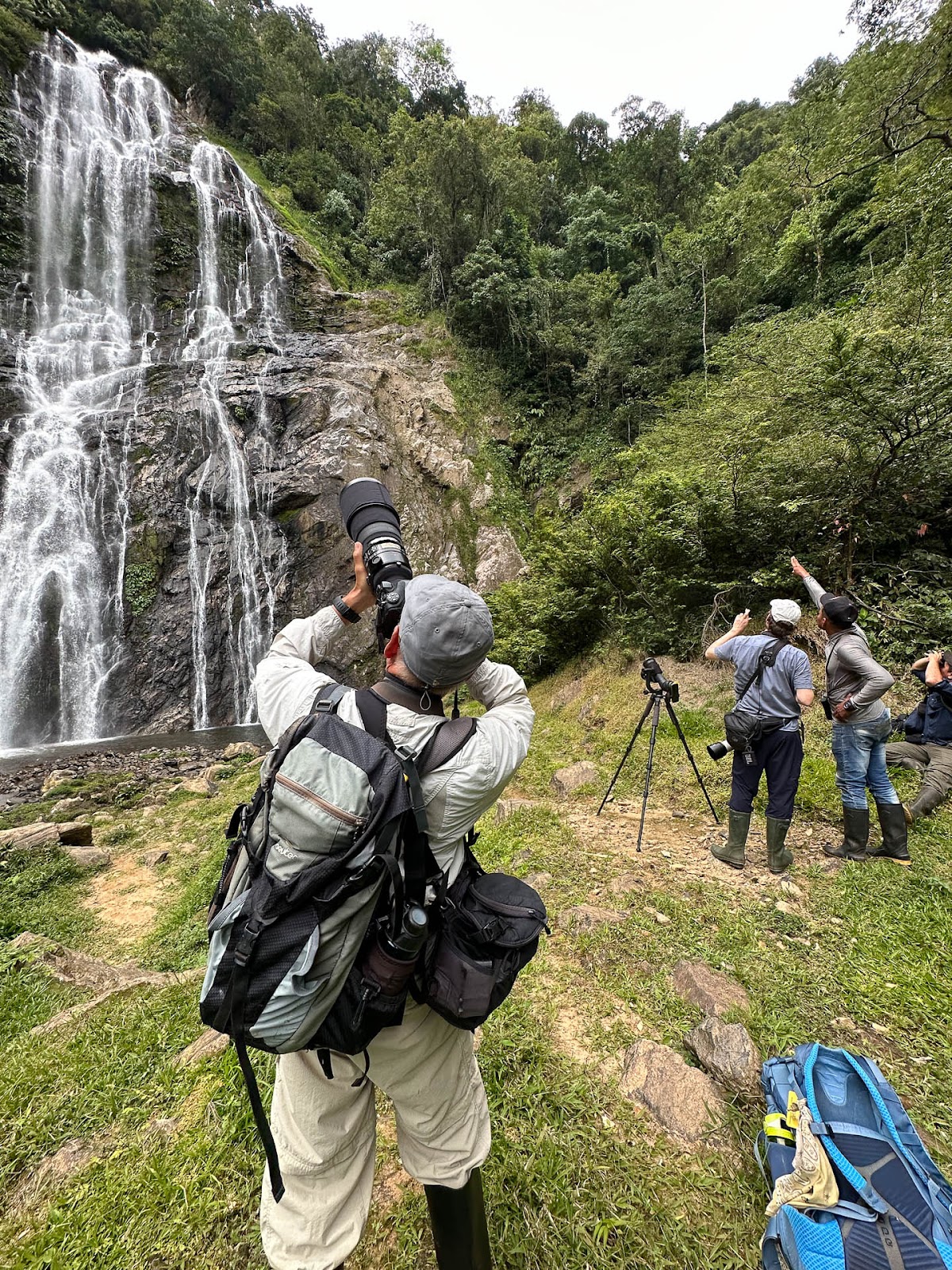








No comments:
Post a Comment